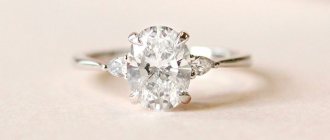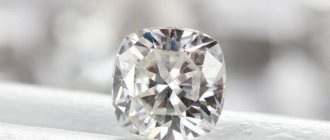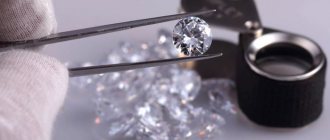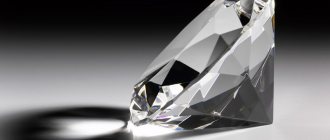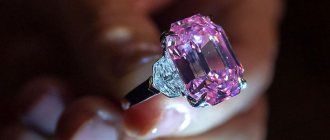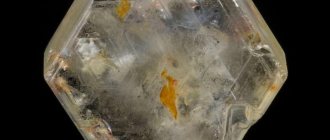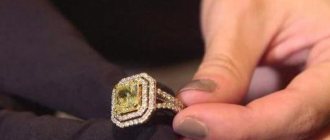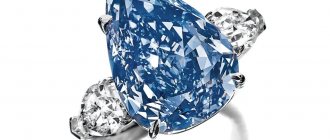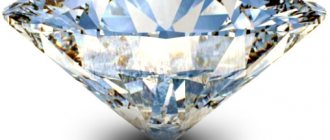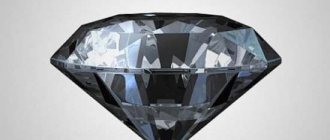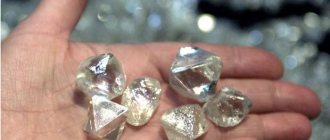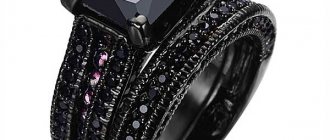Story
Moissanite is the only gem in the world created artificially and then found in nature:
- The idea to create silicon carbide came to the chemist John Berzelius in 1824.
Jöns Jacob Berzelius
Seven decades later, Edward Acheson realized it by designing a furnace and patenting a method for producing a powdered substance under the brand name carborundum in 1893.
Edward Goodrich Acheson - Almost ten years later (1904), the first natural moissanites were discovered in fragments of a meteorite that fell in Arizona (US state). They were found by Ferdinand Moissan. He proved that these are not diamonds or their variety, but an independent mineral. At the suggestion of the famous American gemologist George Kunz, the find was dubbed moissanite.
- Even later, crystals began to be found on Earth, but in only a few cases.
Today, jewelry grade silicon carbide is produced artificially. Until 2015, the monopoly right to production belonged to the United States. Since 2015, several countries have been doing this. Russia and China have achieved particular success.
History of moissanite
The Canyon Diablo meteorite fell many thousands of years ago in the US state of Arizona. In 1893, the French chemist Ferdinand Frederic Henri Moisson began to actively study this cosmic guest. This is how the scientist first discovered the smallest fragments of a completely new mineral, which was later named moissanite in his honor.
The formula for the production of a synthetic analogue was patented by Edward Goodrich Acheson on February 28, 1893. He invented powdered silicon carbide (SiC), and as a result not only established large-scale carborundum production, but also invented a furnace in which the synthetic material is still produced today. Edward Atcherson became the founder of specialized.
Advertising - Continued below
Physico-chemical characteristics
From a chemical point of view, moissanite is silicon carbide with the simplest formula ( SiC ) and basic composition.
However, in colored specimens it is complicated by iron, titanium and other impurities.
| Color | dark green to blue, black |
| Stroke color | greenish gray |
| origin of name | In honor of Henri Moissan (1852-1907), French chemist. |
| Opening place | Canyon Diablo meteorite, Meteor Crater and vicinity, Winslow, Coconino Co., Arizona, USA |
| Opening year | 1893 |
| IMA status | approved |
| Chemical formula | a-SiC |
| Shine | glass semi-metallic |
| Transparency | transparent translucent translucent |
| Cleavage | imperfect |
| Kink | conchoidal |
| Hardness | 9,5 |
| Thermal properties | P. tr. doesn't melt |
| Strunz (8th edition) | 1/B.02-30 |
| Hey's CIM Ref. | 2.1 |
| Dana (7th edition) | 1.3.7.1 |
| Dana (8th edition) | 1.3.8.1 |
| Molecular weight | 40.10 |
| Point group | 6mm – Dihexagonal Pyramidal |
| Space group | P63 |
| Density (measured) | 3.218 – 3.22, average = 3.21 |
| Refractive indices | nω = 2.616 – 2.757 nε = 2.654 – 2.812 |
| Maximum birefringence | δ = 0.038 |
| Type | single-axis (+) |
| Optical relief | very tall |
| Selection form | Small tabular hexagonal plates. |
| Classes on taxonomy of the USSR | Nonmetals |
| IMA classes | Native elements |
| singonia | hexagonal |
What is moissanite?
It is a naturally occurring mineral that was first discovered over 100 years ago.
Although many people think of it as a diamond substitute, the chemical composition of moissanite is very different.
While diamond is made of carbon, moissanite is a form of silicon carbide that is relatively rare in nature, which is why most are manufactured artificially.
This material has a hardness of 9.5 on the Mohs hardness scale, a rating that is very close to diamond, which has a hardness of 10 on the same scale.
Additionally, moissanite looks very similar to diamond and is often used as a diamond imitation.
Where are moissanites found?
The main “deposit” of natural moissanites is meteorites that fell to Earth. But the grains extracted from there are no larger than 4 mm.
Moissanite single crystal ~1 mm in size
The stone is mined in kimberlite pipes, sometimes along with sapphire corundum. Rare, but found inside nugget diamonds.
History of discovery
Natural moissanite was first discovered and described by the French chemist Henri Moissan in 1893.
The future Nobel laureate studied rock samples from a meteorite crater located in Diablo Canyon (Arizona, USA). Moissan mistook them for diamonds, but later found out that the crystals were not made of carbon, but of silicon carbide. A few years later, the find was named after the discoverer - moissanite. For a long time it was believed that moissanite could get to Earth in only one way - from space. Its particles are found in dust clouds that surround carbon-rich stars, as well as in primordial meteorites. Rare on Earth, this mineral is widespread in space.
In 1958, it became clear that not all natural moissanites are of extraterrestrial origin. Minor inclusions were found in kimberlite pipes in Yakutia, and later in other regions. Still, there are very few natural moissanites, and the quality leaves much to be desired.
Varieties
The newest classifications provide for the division into varieties of separately natural and synthetic materials.
Natural moissanite is divided by color:
- dark green;
- black.
The crystals are opaque, with dimensions of 0.5-4 mm.
There are more synthesized varieties:
- transparent, colorless (after cutting they can be said to be a moissanite diamond);
- yellow, “cognac”, blue, green, black crystals of jewelry quality;
- dark-colored specimens for technical use.
In laboratories you can grow moissanite jewelry crystals of all colors except red.
According to their dimensions, the grown raw materials are divided into powder, abrasive crumbs and crystals themselves (4-12 mm).
How is moissanite grown?
To produce synthetic moissanites, the sublimation method developed by Leningrad scientists Tsvetkov and Tairov is used. The raw material is silicon carbide powder, which sublimates into crystals at room temperature. It is exposed to high temperatures - about 2400 degrees, which leads to the formation of moissanite crystals. It takes approximately 15 hours to grow samples weighing up to 200 g.
Other methods for the synthesis of moissanites are also known: crystallization from the liquid phase, “vapor-liquid-solid”. In Russia, moissanites are most often produced by sublimation under high pressure. This allows you to obtain transparent crystals with a gray-green tint.
Synthetic moissanite
The mineral moissanite of jewelry and technical types is synthesized in the laboratory. Industrial-scale production has been established since 1987.
Five synthesis methods have been developed:
- sintering of silica with carbon;
- silicon carbide sublimation;
- from methane;
- heating in a graphite crucible;
- crystallization from a liquid state.
With any method, an artificial material of the required standards is obtained - jewelry or industrial.
History and origin
The first attempts to synthesize silicon carbide in the laboratory were made in 1824 by the Swedish chemist Jens Jakob Berzelius. However, this was only achieved in 1892 by the American chemist Edward Acheson.
Edward Goodrich Acheson
Jons Jacob Berzelius
Having received the first crystalline sample of silicon carbide, he describes it for a patent, after which, a year later, he receives a patent and calls the future mineral carborundum.
Exhibit – Carborundum
In 1904, Ferdinand Frederic Henri Moissan, while examining samples of a meteorite found in Diablo Canyon (Arizona, USA), he discovered hexagonal plates of silicon carbide. This was the first discovery of the mineral in nature, after which it received its name - moissanite.
Areas of use
Moissanite is used in technology, by collectors and jewelers, depending on its origin, dimensions and other conditions:
- Natural crystals are not used - they are too small. They go to collectors - in meteorite blocks or earthly minerals.
- Jewelers work with synthetic moissanite. It is inserted into all types of jewelry.
Ring with synthetic moissanite
The most popular product is a ring with moissanite for all occasions (proposal, engagement, marriage, wedding anniversary, coming of age).
The widest scope of use is for technical moissanite:
- semiconductors, diodes, protective relays, transistors;
- optics (telescopes, other scientific instruments);
- abrasive tools;
- composite armor (coating of nuclear reactors, body armor, and other similar products);
- graphene synthesis;
- additive to foam concrete;
- heating elements.
Oil and gas workers use stone as a catalyst in the oxidation of hydrocarbons.
How to identify origin
Moissanite is both an imitation and an object of counterfeit.
You can independently distinguish the origin in several ways.
Diamond
Diamond and moissanite are considered “twins”: their formula and composition are identical.
A ring with a diamond
The following factors allow you to independently distinguish a diamond from moissanite:
- Examine through a magnifying glass or microscope under the light of a lamp of the growth zone. In grown stones, the growth lines look like ordered, rounded grooves; in diamonds, they are chaotic zigzags or sections.
- Moissanite floats in water, but diamond sinks.
- Look through the stone: moissanite will reveal twice the number of facets.
- A flame (even from a match) does not change the color of the diamond; moissanite turns green.
The easiest way is to take a sample with your hands. The fingerprint will only remain on the diamond.
cubic zirconia
Cubic zirconia is often offered under the guise of moissanite. It is cheaper, easily becomes cloudy, dark, and chips.
cubic zirconia
A sheet of white paper will help you distinguish between cubic zirconia and moissanite. A black dot is drawn on it and the sample is placed on it with the flat side. The pattern under the cubic zirconia will be clearly visible in all edges and will retain its dimensions.
Production of synthetic moissanite
Carborundum (artificially grown moissanite) has been mass produced since 1987. They learned to make colorless stones in 1998. Jewelry and technical grades of the mineral are synthesized in laboratories. The first ones are distinguished by their purity and radiance. The second crystals are grown dark.
The stone is synthesized using five methods:
- silica is sintered with carbon at temperatures above 1600 ºC;
- silicon carbide is sublimated at 2500 ºC and the temperature is reduced, causing the substance to settle on the substrate (Lely method);
- Lelya’s method is supplemented by heating in a graphite crucible (special container);
- crystallizes from a liquid state;
- converted from methane.
Artificial and natural diamonds are distinguished from moissanite by their growth zones. At home, use a magnifying glass or microscope or lamp.
Synthesized stones have growth lines that resemble rounded grooves on a gramophone record. In natural diamonds, these are thin planes that look like unequal zigzags or oddly shaped areas. The zones lie parallel to the crystal lattice, and in moissanite they are tube-shaped, growing from the inside to the top.
Moissanites and loose diamonds are tested in water. The synthesized silicon carbide will float at the top. The diamond will sink. The second harmless way is to look through the stone. Moissanite will show twice the number of facets.
How to distinguish from cubic zirconia
Moissanite is more expensive than cubic zirconia, but it is better: it retains its presentation much longer, the edges do not chip when struck, and the surface does not wear down.
Properties of cubic zirconia:
- chemical formula – ZrO2 (zirconium dioxide);
- Mohs hardness – 8.5;
- variance – 0.060.
Cubic zirconia and moissanite are distinguished visually. A black dot is drawn on a white sheet. Place a stone on top of the mark (flat side). They look at the sign through the mineral. The pattern under the cubic zirconia will retain its clarity and size and will be visible in all edges.
Watch a video review with examples of stones:
How to distinguish moissanite from diamond
Moissanite is distinguished from diamond by an optical method. It is the most reliable and does not damage gems. A microscope, dichroscope, and x-ray are used.
Differences between diamond and moissanite:
- harder according to Mohs scores;
- shines worse;
- heavier by 10% specific gravity;
- Cold shades predominate in color reflection.
Moissanite without internal defects. There is birefringence, a rainbow spectrum of reflection. The stone absorbs UV rays and glows red-orange under ultraviolet light. During X-ray testing, diamonds turn blue, green, yellow, and red.
Moissanite and diamond are also distinguished by the following methods:
- heating the surface with fire;
- compression;
- electrical conductivity;
- thermal conductivity;
- weighing;
- according to Hodgkinson.
These methods are used only by gemologists. You need special equipment. In addition, strength testing and heat treatment destroy stones.
A thick fingerprint is visible on a diamond under a magnifying glass, and the stone does not change color when heated by fire. Moissanite turns green over the flame, leaving no impressions on the surface.
In addition, watch a video about the differences:
How to wear
A cut stone looks like a diamond and even better. The frame for it is made of precious metals - silver, platinum, gold of different shades.
When choosing products, the time of day, occasion, color matter:
- Pendant or stud earrings are suitable for the office.
- A bracelet, necklace, earrings with several stone inserts larger than a carat (6.5 mm) are worn for status or evening outings.
- Black moissanite is more suitable for men's assortment (cufflinks, ring, ring, tie clip). Miniature inserts in studs, pendants, and rings are organic in a woman's wardrobe.
During the day, it is not recommended to wear several jewelry with large stones or a large number of them at once. This is acceptable at evening receptions.
Moissanites are not combined with other stones (except cubic zirconia), especially semi-precious or ornamental ones.
Physical properties
The hardness of moissanite is 9.25 on the Mohs scale. By this indicator, it exceeds any other minerals, with the exception of diamond. The high hardness of moissanite means that it is almost impossible to scratch: after decades, the stone will look like new.
Moissanite is a refractory material. The melting point is 2830 degrees, which allows the stone to withstand the technological process of jewelry production and repair. It is also resistant to aggressive chemical compounds used in industry. Moissanite is not afraid of household chemicals - ammonia, chlorine, bleach.
Price
The Russian market is saturated with moissanite products of all types, colors and sizes. Reputable companies and single craftsmen deal with stone.
Prices depend on the frame material, quantity and dimensions of inserts (thousand rubles):
- wedding ring (gold) – 24.2 – 46.6;
- bracelet (gold) – 62.9;
- pendant (silver) – 1.2.
The price of moissanite is measured in carats, just like a diamond. There is no clear figure for 1 carat, but an artificial stone can be bought 10-30 times cheaper than a diamond of comparable dimensions and condition.
Thus, the price range for American-made stones is $110 (0.5 carats) – $495 (1.5 carats). Diamond analogue – $2.5-20 thousand.
How to distinguish moissanite from diamond
One of the optical tests to distinguish Charles & Colvard moissanite from a diamond
The magnificent “game” of moissanite was appreciated by many fans of precious items. The stone turned out to be a real find for the jewelry industry.
With characteristics that are not inferior to diamonds, the cost of moissanite is significantly lower than its older brother, and is approximately $400–600 per 1 carat versus a diamond carat costing $6,000–$10,000.
However, the stone born in the laboratory became not only a sensation, but also a headache. After all, it is very difficult to distinguish moissanite from a diamond. Although, there are still some features that allow you to find out who is who.
Therapeutic effect
Lithotherapists recognize the positive effect of the stone in diseases of the nervous system:
- Sparkling moissanite, by its very appearance, can relieve black melancholy, depression, or reduce aggression.
- Contemplation of a colorless stone or a stone of delicate shades (blue, green, pink) improves the functioning of the body as a whole.
- This is useful for women experiencing menopause.
For a healthy person, wearing a product with moissanite or contemplating the stone results in a surge of energy, improved memory, and relief from stress after work.
Magic properties
The following magical properties of moissanite have been revealed:
- Attracts money (especially yellow or green).
- Strengthens the spirit, gives courage, raises self-esteem.
- Protects from unwanted outside influence.
- Helps to define a goal, control emotions, makes a speaker.
The magic of moissanite will support the owner in any difficult situation and streamline life.
A stone of any origin is suitable for magical purposes. But the synthetic one needs to be activated by exposing it to the sun before dawn.
Magical properties of the mineral
Artificial stone does not have healing qualities, but this deficiency is compensated by amazing magical properties. A precious mineral grown in laboratory conditions, due to its unique characteristics, can be compared with natural gems. The rainbow glow of its facets has a beneficial effect on the nervous system, freeing a person from depression, fear and indecision.
The owner of moissanite becomes calmer and more balanced, he acquires the ability to defend his opinion, becomes inventive and eloquent. The stone gives its owner courage, determination and willpower.
Carborundum transforms nervous tension into a productive desire to move forward, helps you calm down in time and cope with difficult life circumstances. The owner of the stone gains learning abilities, his intellectual abilities and memory improve.
